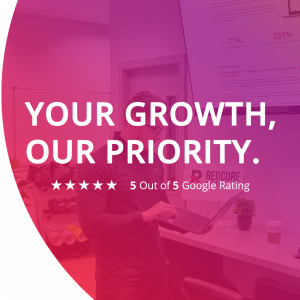What Is A Blog?
At the beginning of the internet, a blog was categorised as a personalised homepage where users journaled their life.
As the internet has grown, so has the use of blogs, now a blog is used to give business updates and provide information and value to a reader.
as well as for personal use to voice views and opinions.
For example, our blog at RedCore Digital is used to showcase our expertise and specialities We write about SEO tips and tricks, Copywriting best practices and Webdesign trends.
Can Anyone Write A Blog?
Starting up a blog can be done by most but, it’s whether you can give it the dedication and attention it needs to become successful.
In order to establish credibility, successful blogs require dedication, planning, and commitment, which entails taking into account a multitude of variables.
- Consistent Posts
- Engaging writing style
- Relevant topics to your audience
- Research & pick a platform

How To Write A Good Blog Post
1. Begin By Outlining The Topics
When considering the possibility of creating a blog the most crucial component to consider is the topic.
Is it based on your business?
Is it for personal interest?
When selecting a topic, it is crucial to carefully contemplate the intended audience, considering factors such as whether the audience is niche, mass, professional, or recreational.
Outlining the topics also allows you to plan ahead and research topics for when you begin writing your blog.
Finally, outlining the topics allows you to better understand the benefits your blog will give to your audience, whether that be information and expertise, opinion and review.
Deciding on this information before beginning to create your blog will assist you in creating a highly effective content strategy and start your blog off on the right foot.
2. Define The Target Audience
As previously mentioned, defining your target audience is essential, without fully understanding your target audience and demographic it’s hard to know who you wish to read your blog.
Defining your target audience allows you to specifically plan your content, as you begin to write and publish your content you will learn more about your audience but it’s important to have a rough outline.
One of the simplest ways to define your target audience is to create an audience profile.
What is an audience profile?
An audience profile includes
- Age
- Gender
- Income
- Profession
- Interests
Developing an audience profile facilitates the inclusion of pertinent details within a blog post that aligns with the specific interests of the intended readership, thereby increasing the likelihood of effectively reaching those who are invested in the genre of writing in question.
3. Choose A Blog Template
Creating a new blog comes with its own set of challenges, ensuring you pick the right blog template for you is essential.
What is a blog template?
A blog template is what formatting you use, it’s important to ensure your blog formatting is consistent across every post, for example
- Headings
- Font styles
- Introduction
- Summary
- Bullet points
Implementing a standardised template for your blogs can enhance their user-friendliness and foster a positive reading experience for the intended audience.
Thereby increasing the likelihood of securing return visitors and gaining a favourable reputation through positive word-of-mouth and social media engagement.
There are a few ways you can create a standardise writing template, it can even be shared via multiple parties within a business organisation if needed.
Here at RedCore Digital, we use Google Documents via google drive but there our other opticians available, for example
- Mircosoft Word
- Evernote
- Google Documents
- Blogo
These are some examples of different available digital writing software.
There are many available options to create your writing template, so do some research and decide which one works best for you or your business.
4. Refine Your Topic With Keyword Research
Writing a blog can sometimes be an overwhelming experience so it’s important to define your topics before you begin writing, although there are a few ways you could refine your topic.
If you’re looking to create a successful blog, one of the most effective ways to gain visibility is through SEO.
SEO stands for Search Engine Optimisation.
It’s the practice of improving a website’s visibility and ranking in search engine results pages.
By optimising various factors like keywords, content quality, and website structure, SEO helps increase organic traffic and attract more visitors to a website.
There are a multitude of different available keyword research tools such as
- SEMRush
- Google Search Console
- Soovel
SEO involves conducting keyword research to gain insights into the relevant topics and search terms with search volume.
This research helps in optimising blog posts by incorporating specific words and phrases that users are actively searching for. Organizing the identified keywords within headings and subheadings in a document facilitates the content creation process, providing a structured approach and enhancing efficiency.

5. Explain Your Connection To The Topic
Explaining your personal connection to the topic can create a positive relationship between you, the writer and the reader.
If the reader feels your expertise, opinion or review is written from a positive perspective it increases the possibility of returning traffic and a loyal audience.
Building a trusted relationship with readers can also increase the likelihood of advocacy, therefore, increasing the traffic and popularity of your blog.
For example, I’m a copywriter working in SEO so my expertise and knowledge are in this very field of work, meaning I have the knowledge and experience to help others to begin the blog-creating process.
6. Write Passionate & Compelling Copy
As a writer, it’s important to ensure your blog shows the reader that you are passionate about the topic you writing about.
If the reader feels you haven’t given the topic enough dedication and attention they may not feel like the information is incorrect and choose an alternative website to receive their information from.
If you wish to achieve a successful blog it’s important to write compelling copy
How do you write compelling copy?
- Speak directly to the reader
- Use emotion
- Create urgency
- Incorporate metaphors and analogies
- Be specific, close all points
- User-friendly format
7. Write An Attention-Grabbing Title
Many inexperienced writers may create the title before writing the blog, although that’s okay and can allow for a creative and attention-grabbing title.
I would recommend writing the title after the blog is completed as you can take key elements of your blog and include them into the title.
For example, if you have a 5-point list you could write “5 tips & tricks” This allows the reader to understand that there are five different pieces of advice and Knowledge to absorb within your blog.
in comparison to another blog with a less specific title, this could be the decision-maker between your blog and a competitor.
8. Include Relevant Photos/Images
We’ve discussed writing a blog, but what else needs to be included?
Including images and/or photographs allows you to use visual content that enhances the overall appearance and aesthetics of the blog, making it more visually appealing and engaging for readers.
Images can help break up the text and make the content easier to digest.
Secondly, images can effectively convey information, concepts, or data that might be difficult to explain through text alone.
They can provide visual examples, diagrams, charts, or infographics to support and supplement the written content, enhancing clarity and understanding for readers.
Finally, Images can also improve the SEO of a blog.
By optimising image file names, alt tags, and descriptions with relevant keywords, you can enhance the visibility of your blog in image search results and attract additional organic traffic.
Where To Publish A Blog
1. WordPress
WordPress is a popular and user-friendly content management system used for blog publishing and website creation.
It provides a simplified platform that allows individuals and businesses to easily create, customize, and manage their blogs without extensive technical knowledge.
WordPress offers a wide range of customisable themes and templates that determine the overall design and layout of your blog.
These themes can be customised to match your brand identity or personal preferences, giving your blog a unique and professional look.
You can create and organise your blog posts using a straightforward editor.
The editor enables you to format text, insert images, embed media, and add links, making it easy to create engaging and visually appealing blog content.

2. Wix
Wix is a website builder platform that allows users to create and publish blogs and websites with ease. It provides a drag-and-drop editor, making it accessible to individuals and businesses without extensive technical knowledge or coding skills.
The platform provides a straightforward blog editor that enables you to create and format your blog posts.
You can add text, images, videos, and other media elements to your posts, making them visually appealing and engaging for your readers.
Wix has a user community and support system that offers resources, tutorials, and assistance to help you navigate the platform and troubleshoot any issues you may encounter.
3. Weebly
Weebly is a website builder and hosting platform that provides an intuitive and user-friendly interface for creating and publishing blogs.
It offers a range of features and tools specifically designed to facilitate blog creation and management.
In terms of hosting, Weebly provides reliable and secure hosting for your blog.
You don’t need to worry about finding separate hosting services as it’s included in the Weebly package.
Do You Get Paid For Writing Blogs?
Working in digital marketing can allow you to get paid to write blogs, but it’s slightly more complex than that.
Many things of digital marketing as social media advertisement but beyond that, there is so much more.
By developing the necessary skills in SEO, you can explore opportunities as a professional copywriter.
This entails being paid not only for writing blogs but also for conducting keyword research and crafting content briefs.
In this role, you can leverage your expertise to create optimised content that aligns with target keywords, engages readers, and achieves desired search engine rankings.

Why Write Blogs?
There are a number of benefits to writing and incorporating blogs, whether it be your job or a hobby there are many reasons to start up a blog.
- Assists in Building an Engaged Audience
- Assists in adapting content for various marketing channels
- Brings Traffic to Your Website
- Helps you Build Authority
How To Start A Blog
1. Explain The Topics That Will Be Used
Using a content page allows you to showcase all the key elements of your blog and entice the reader before they’ve gotten to the good bit.
Using an interactive contents page allows the user quickly and efficiently find the information they are looking for meaning they may favour your blog over a competitor for a better user experience.
2. Introduce Yourself As A Writer
It’s important to showcase an individual writing style within your work.
Depending on the style and type of blog your writing the writing style can differ slightly but it’s key to show off any unique creative flare that sets you apart from other blog creators/writers.
Allowing your writing to convey personality will also increase the likelihood of creating a positive and trusting relationship with readers, clients or new inquiries.
If the blog writing is for professional purposes it’s also important that the writing conveys your brand and tone of voice to allow clients to understand the core values of the business.
TL;DR
There has been a lot of information within this blog so it’s understandable if you feel overwhelmed, so let’s round it up.
Starting a blog can be made simple if you use the guide above.
Firstly, ensure to conduct research thoroughly before beginning any writing.
After you’ve conducted your research begin outlining and creating a plan.
Once your research and plan have been concluded and you are happy to move forward, begin looking for a content management system and/or creating your template you can do these steps either way around.
Now comes the fun part!
Begin writing your blog, whatever the topic, make it fun, interesting and valuable, and ensure to add images, infographics and other eye-catching elements.
Enhance user engagement and encourage prolonged website visits by leveraging internal links to showcase your other blog posts, thereby increasing the probability of readers exploring additional content on your site.
Now to publish!
Now the blogs are ready and you’ve chosen your content management system it’s time to upload them and get ready to press that live button, ensure you’ve proofread and checked for errors.
If all is clear and you are happy send it live and enjoy the satisfaction of blog writing.








